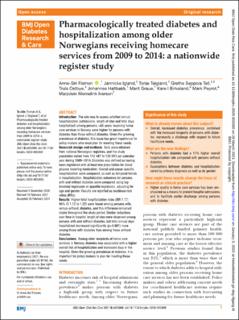| dc.contributor.author | Fismen, Anne-Siri | |
| dc.contributor.author | Igland, Jannicke | |
| dc.contributor.author | Teigland, Tonje | |
| dc.contributor.author | Tell, Grethe S. | |
| dc.contributor.author | Østbye, Truls | |
| dc.contributor.author | Haltbakk, Johannes | |
| dc.contributor.author | Graue, Marit | |
| dc.contributor.author | Birkeland, Kåre I. | |
| dc.contributor.author | Peyrot, Mark | |
| dc.contributor.author | Iversen, Marjolein M. | |
| dc.date.accessioned | 2022-01-24T09:42:22Z | |
| dc.date.available | 2022-01-24T09:42:22Z | |
| dc.date.created | 2021-07-08T10:00:44Z | |
| dc.date.issued | 2021 | |
| dc.identifier.issn | 2052-4897 | |
| dc.identifier.uri | https://hdl.handle.net/11250/2838881 | |
| dc.description.abstract | Introduction
The aim was to assess whether annual hospitalization (admissions, length of stay and total days hospitalized) among persons >65 years receiving home care services in Norway were higher for persons with diabetes than those without diabetes. Given the growing prevalence of diabetes, this issue has great importance for policy makers who must plan for meeting these needs.
Research design and methods
Data were obtained from national Norwegian registries, and the study population varied from 112 487 to 125 593 per calendar year during 2009–2014. Diabetes was defined as having been registered with at least one prescription for blood glucose lowering medication. Overall and cause-specific hospitalization were compared, as well as temporal trends in hospitalization. Hospitalization outcomes for persons with and without diabetes were compared using log-binomial regression or quantile regression, adjusting for age and gender. Results are reported as incidence rate ratios (IRRs).
Results
Higher total hospitalization rates (IRR 1.17; 95% CI 1.12 to 1.22) were found among persons with, versus without, diabetes, and this difference remained stable throughout the study period. Similar reductions over time in hospital length of stay were observed among persons with and without diabetes, but total annual days hospitalized decreased significantly (p=0.001) more among those with diabetes than among those without diabetes.
Conclusions
Among older recipients of home care services in Norway, diabetes was associated with a higher overall risk of hospitalization and increased days in the hospital. Given the growing prevalence of diabetes, it is important for policy makers to plan for meeting these needs. | en_US |
| dc.language.iso | eng | en_US |
| dc.publisher | BMJ Publishing Group | en_US |
| dc.rights | Navngivelse-Ikkekommersiell 4.0 Internasjonal | * |
| dc.rights.uri | http://creativecommons.org/licenses/by-nc/4.0/deed.no | * |
| dc.title | Pharmacologically treated diabetes and hospitalization among older Norwegians receiving homecare services from 2009 to 2014: a nationwide register study | en_US |
| dc.type | Journal article | en_US |
| dc.type | Peer reviewed | en_US |
| dc.description.version | publishedVersion | en_US |
| dc.rights.holder | Copyright Author(s) (or their employer(s)) 2021. | en_US |
| dc.source.articlenumber | e002000 | en_US |
| cristin.ispublished | true | |
| cristin.fulltext | original | |
| cristin.qualitycode | 1 | |
| dc.identifier.doi | 10.1136/bmjdrc-2020-002000 | |
| dc.identifier.cristin | 1920928 | |
| dc.source.journal | BMJ Open Diabetes Research & Care | en_US |
| dc.identifier.citation | BMJ Open Diabetes Research & Care. 2021, 9 (1), e002000. | en_US |
| dc.source.volume | 9 | en_US |
| dc.source.issue | 1 | en_US |

